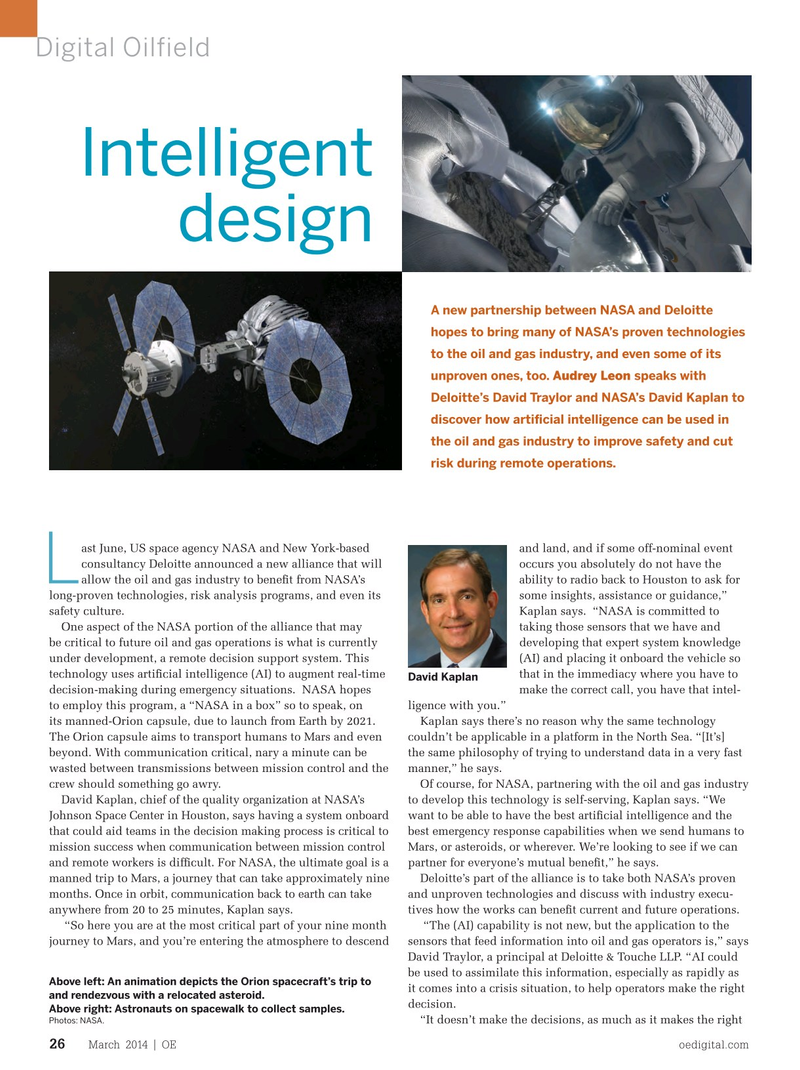
Page 24: of Offshore Engineer Magazine (Mar/Apr 2014)
Read this page in Pdf, Flash or Html5 edition of Mar/Apr 2014 Offshore Engineer Magazine
Digital Oilfield
Intelligent design
A new partnership between NASA and Deloitte hopes to bring many of NASA’s proven technologies to the oil and gas industry, and even some of its unproven ones, too. Audrey Leon speaks with
Deloitte’s David Traylor and NASA’s David Kaplan to discover how artifcial intelligence can be used in the oil and gas industry to improve safety and cut risk during remote operations.
ast June, US space agency NASA and New York-based and land, and if some off-nominal event consultancy Deloitte announced a new alliance that will occurs you absolutely do not have the
L allow the oil and gas industry to beneft from NASA’s ability to radio back to Houston to ask for long-proven technologies, risk analysis programs, and even its some insights, assistance or guidance,” safety culture. Kaplan says. “NASA is committed to
One aspect of the NASA portion of the alliance that may taking those sensors that we have and be critical to future oil and gas operations is what is currently developing that expert system knowledge under development, a remote decision support system. This (AI) and placing it onboard the vehicle so technology uses artifcial intelligence (AI) to augment real-time that in the immediacy where you have to
David Kaplan decision-making during emergency situations. NASA hopes make the correct call, you have that intel- to employ this program, a “NASA in a box” so to speak, on ligence with you.” its manned-Orion capsule, due to launch from Earth by 2021. Kaplan says there’s no reason why the same technology
The Orion capsule aims to transport humans to Mars and even couldn’t be applicable in a platform in the North Sea. “[It’s] beyond. With communication critical, nary a minute can be the same philosophy of trying to understand data in a very fast wasted between transmissions between mission control and the manner,” he says.
crew should something go awry. Of course, for NASA, partnering with the oil and gas industry
David Kaplan, chief of the quality organization at NASA’s to develop this technology is self-serving, Kaplan says. “We
Johnson Space Center in Houston, says having a system onboard want to be able to have the best artifcial intelligence and the that could aid teams in the decision making process is critical to best emergency response capabilities when we send humans to mission success when communication between mission control Mars, or asteroids, or wherever. We’re looking to see if we can and remote workers is diffcult. For NASA, the ultimate goal is a partner for everyone’s mutual beneft,” he says.
manned trip to Mars, a journey that can take approximately nine Deloitte’s part of the alliance is to take both NASA’s proven months. Once in orbit, communication back to earth can take and unproven technologies and discuss with industry execu- anywhere from 20 to 25 minutes, Kaplan says. tives how the works can beneft current and future operations.
“So here you are at the most critical part of your nine month “The (AI) capability is not new, but the application to the journey to Mars, and you’re entering the atmosphere to descend sensors that feed information into oil and gas operators is,” says
David Traylor, a principal at Deloitte & Touche LLP. “AI could be used to assimilate this information, especially as rapidly as
Above left: An animation depicts the Orion spacecraft’s trip to it comes into a crisis situation, to help operators make the right and rendezvous with a relocated asteroid. decision.
Above right: Astronauts on spacewalk to collect samples.
Photos: NASA.
“It doesn’t make the decisions, as much as it makes the right
March 2014 | OE oedigital.com 26 000_OE0314_Digital2-NASA.indd 26 2/21/14 11:46 AM

 23
23

 25
25